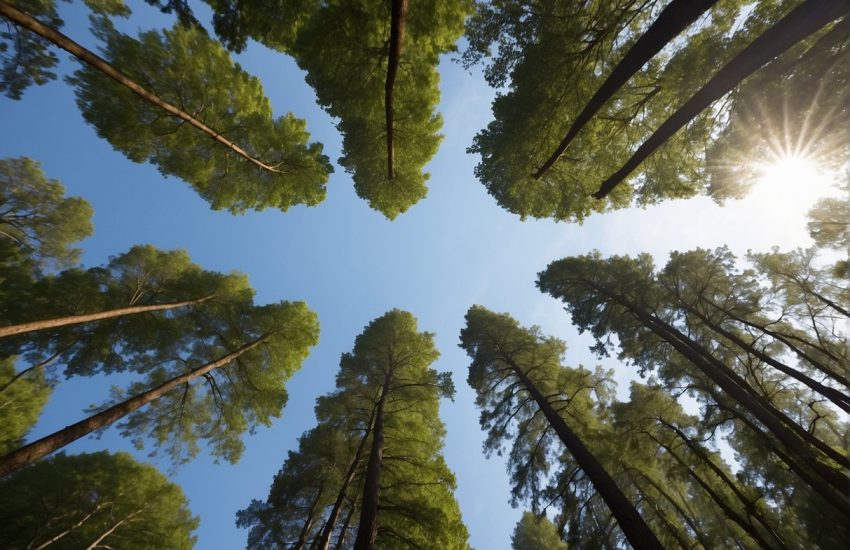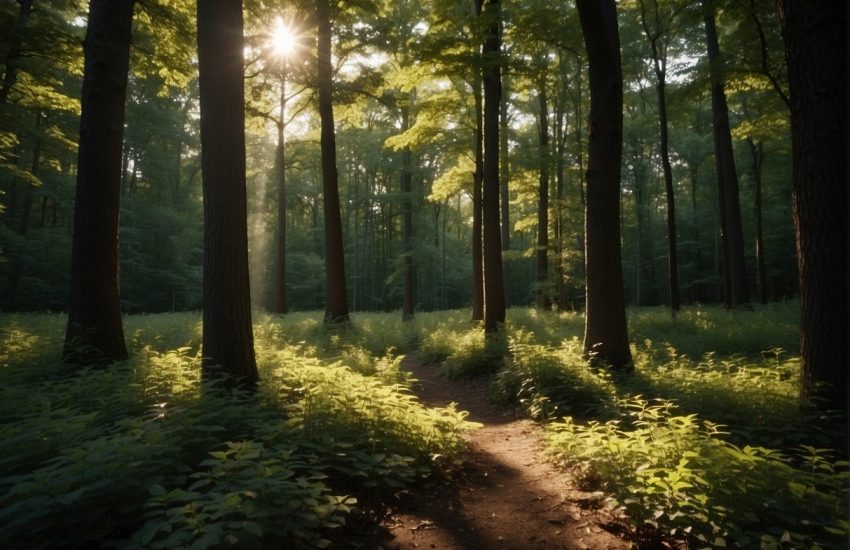The Most Beautiful Ornamental Trees to Grow in Wisconsin
Wisconsin is a state that enjoys beautiful landscapes and a wide variation of beautiful scenes. There are ridges and valleys in the Driftless area, rolling hills, forests and fields stretching from the Northwoods southward to productive farms from the center of the state extending to the East and the West. The metropolitan areas of Milwaukee and Madison offer an urban environment to residents as well. The Badger State has what is considered a continental climate with warm summers followed by winters that can be fairly cold in the northernmost areas.
Residents who are wanting to beautify their homes with ornamental or flowering trees are fortunate since the state is home to a good number of flowering trees. There are native and non-native trees in sizes that will fit into the front lawn or a backyard of various sizes. Homeowners can choose ornamental trees that bloom in spring, summer and fall to beautify their landscape whatever the season.
Korean Lilac Tree
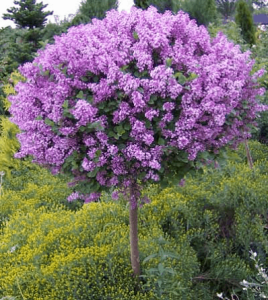
Korean Lilac can be grown as a large shrub, but it is most often pruned into the form of a small tree. This small ornamental tree is valued as one of the most fragrant and colorful varieties of lilacs and enjoys increasing popularity. Although blooms appear a bit later in the season than traditional lilacs, they provide long-lasting color and a lovely scent into early summer.
The versatile Korean Lilac grows best in USDA zones 4 through 8, so it is most likely to be found growing in the central and southern areas of Wisconsin. Since the mature height and width are from five to seven feet, this lilac can fit into various locations of the landscape.
The planting and care of the Korean Lilac are simple with location being the most important decision. This lilac needs at least 6 hours of full sun per day, and it does best in well-drained soil. It is essential to water the plant thoroughly once it is in the ground, and it should be watered regularly once a week until it is established. Although it is considered drought tolerant, it may need additional watering during an especially long dry spell. Fertilizer is beneficial once or twice during the year after it begins to bloom. Pruning is recommended to maintain the preferred size and shape after it starts blooming.
Prairifire Crabapple

Prairifire Crabapple is one of the most beautiful trees in spring with clouds of pink blossoms covering the tree. The purple and red leaves remain to bring showy color even after the flowers have fallen. This beautiful ornamental tree grows up to 20 feet in height and grows best in USDA zones 4 through 8. Even after the colored leaves have fallen, the gray and orange bark and red berries still on the tree offer a pop of color in winter. Additionally, birds love the fruit so there is no need to clean up the wilted berries that have fallen under the tree. Many crabapple trees die from disease after several years, but the Prairifire is highly resistant and provides beauty to the landscape season after season.
The Prairifire Crabapple tree requires only simple maintenance once established. It should be planted in mildly acidic, well-drained soil and requires full sun throughout the day. Crabapple trees typically do well in Wisconsin with its moderate temperatures and rainfall, but they benefit from weekly watering during a long dry spell. Adding a 5-5-5 fertilizer in early spring is recommended each year. It is also important to check the tree for dead and damaged branches in late spring before the flower buds appear.
Sweetbay Magnolia
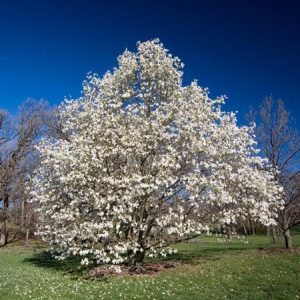
Sweetbay Magnolia is a relatively large tree that can reach 35 feet in height at maturity. The tree is covered with large, creamy-white flowers that have a lemony scent. This beautiful tree that blooms from late spring throughout the summer tolerates heat, cold and wet or boggy soil. The semi-evergreen tree prefers full sun or partial shade, but there will be more of the lovely flowers with at least 6 hours of direct sunlight each day. The USDA zone requirement ranges from 5 through 10 so the most favorable location in the state will be the southeast, but homeowners should check to be sure their zone is appropriate for the tree.
This Magnolia tree can be located anywhere in the landscape, but it does prefer slightly acidic soil that is fairly moist. Mulching with pine bark or straw up to three inches provides acidity that breaks down and it should be replaced every year. In addition, a regular watering schedule is beneficial if rainfall is not sufficient during a prolonged dry period.
Butterflies and bees love the fragrant flowers of the Sweet Bay Magnolia Tree, and songbirds feast on the bright red seeds that appear at the end of summer. Deer tend to avoid the tree, but if there is a high number of deer in the area repellant can be applied to discourage them. Trees located in milder climates may keep their leaves throughout the winter, but those located in the colder locations of Wisconsin will drop their leaves.
Purple Wisteria

Purple Wisteria is an outstanding ornamental tree available to Wisconsin homeowners. The tree may be relatively small at a mature height of 10 feet, but it makes up for its smaller size with an amazing summer display of abundant purple flowers that are deliciously fragrant. Not only does this tree make a bold statement in the landscape, but it is resistant to drought, pests and disease. This hardy little tree is not particular about about soil type, but prefers full sun exposure on the southern side of a building. While the Wisteria is beautiful and hardy, it should be noted that the blossoms are toxic and care should be taken that pets do not eat them.
Eastern Redbud
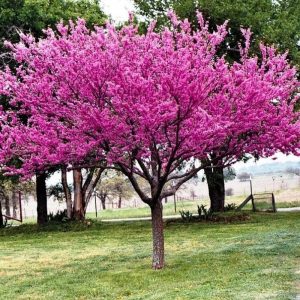
Eastern Redbud is an early harbinger of spring, its bright blooms are among the earliest to appear as warmer temperatures return to Wisconsin. The tree is quite hardy In spite of its rather delicate appearance. It thrives in warmer climates and survives temperatures as low as -20 degrees and is not damaged by ice. The tree grows well in USDA zones 4 through 9 and tolerates most types of soil.
When planting an Eastern Redbud Tree the location should provide full to partial sun, and the young tree should be watered on a weekly schedule for the first year. The tree should survive on rainfall alone once established except during a prolonged dry period. Compost and a complete fertilizer should be applied in early spring.
Autumn Flowering Cherry

Autumn Flowering Cherry is one of the few trees that produce flowers in autumn. Not only does the tree produce flowers, but the fall foliage becomes colorful turning to shades of red, yellow, bronze and gold. The average size of this beautiful and unique tree is 20 to 30 feet high at maturity with a spread of 15 to 30 feet. The USDA growing zone for the Autumn Cherry tree is 4 through 8 and it tolerates various soil conditions that are acidic, loamy, clay, moist or well-drained. It needs at least four hours of direct sunlight per day and lives longer than other cherry trees since it is tolerant of cold and stress. Although this cherry tree does bloom in the fall, it produces much more abundant flowers in the spring.
Chaste Tree
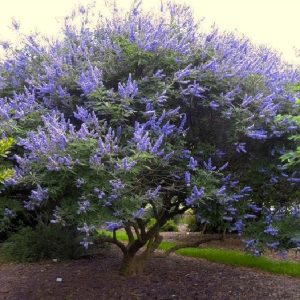
Chaste Tree is a small deciduous tree that is not only beautiful but requires little maintenance. Purple flowers appear in clusters on the end of the branches in summer and leave small black fruits containing four seeds similar to pepper corns inside. The seeds inside the pods are sometimes used to flavor food.
One unique characteristic of the Chase tree is its extremely rapid growth since it may grow up to 7 feet in one season. It’s easy to grow Chase trees since most soils are tolerated, but at least six or more hours of sunlight each day is necessary. The USDA zone requirement is 5 through 9 so gardeners in the southeastern part of Wisconsin will be most successful with this variety of ornamental tree.
Hawthorn
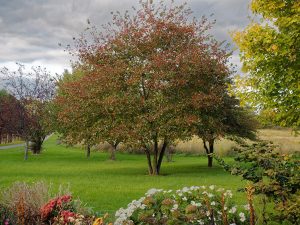
Hawthorn is a beautiful and hardy tree that can grow anywhere in Wisconsin. The tree survives the cold winter temperatures of northern Wisconsin and is approved for USDA zones 3 through 7. The Hawthorn can reach a mature height of 15 to 30 feet, but also can have a spread of 35 feet. For this reason adequate space in the yard is required. The Hawthorn tree needs full sun and soil that is well-drained and slightly moist.
This ornamental tree produces many white flowers in late spring and early summer. Since the flowers are quite fragrant they do attract insect pollinators. After the flowers are gone, small red fruits appear which are a food source for birds in late summer and fall. The foliage of the tree turns vibrant shades of red and orange in the fall providing another show of color in the landscape. Most Hawthorn trees have large thorns, but there is a variety called Cockspur Hawthorn that has no thorns which may be preferred by the homeowner with children.
Autumn Brilliance Serviceberry Tree
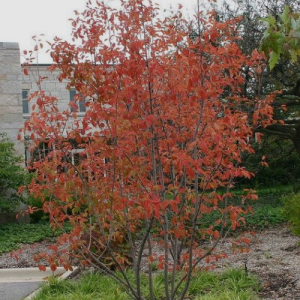
Autumn Brilliance Serviceberry grows well in USDA zones 4 through 9, and reaches a mature height up to 25 feet. It grows best in well-drained soil and requires at least 6 hours of direct sun. Regular watering is recommended until the tree is established, and it should be fertilized after it begins blooming.
The tree produces white blossoms in spring that become flavorful berries that resemble blueberries and are used to make preserves. As the name implies, the Autumn Brilliance Serviceberry tree provides spectacular color in fall with vibrant orange and red-colored leaves.
Pink Dogwood
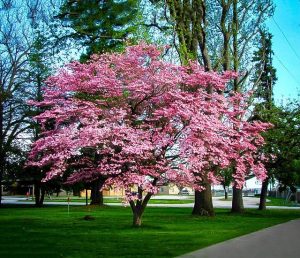
Pink Dogwood welcomes spring with unique pink flowers that begin as a light shade of pink and get darker when the tree ages so there is great variation in color. This lovely spring bloomer grows to a mature height of up to 25 feet and grows well in USDA zones 4 through 9. The abundant flowers leave bright red berries that are enjoyed by Cardinals and other songbirds. Bright red leaves provide vibrant fall color and the cinnamon checkered bark adds visual interest throughout the winter months.
This Dogwood tree requires well-drained soil and full to partial sun with afternoon shade preferred. The Pink Dogwood requires very little if any maintenance since it is drought tolerant and continues growing even in temperatures as low as -10 degrees. A good layer of mulch helps to retain moisture and should be pulled back 6 inches from the trunk. Drooping leaves mean the tree needs water while lightened leaves indicate too much water. Dogwoods generally do not require feeding, but a general use fertilizer can be applied in April or May if desired.
Bottom Line
Residents of Wisconsin are fortunate since the climate of the state varies with relatively mild temperatures in the southern and eastern areas that are influenced by Lake Michigan. For those who prefer cooler temperatures, the northern and northwestern areas of the state are the best choice. Dense forests surround many lakes and rivers so that area is a popular vacation destination. Homeowners in every area of the state can find beautiful ornamental trees that blossom in spring, produce fruit in summer and greet fall with a vibrant show of colored leaves.

